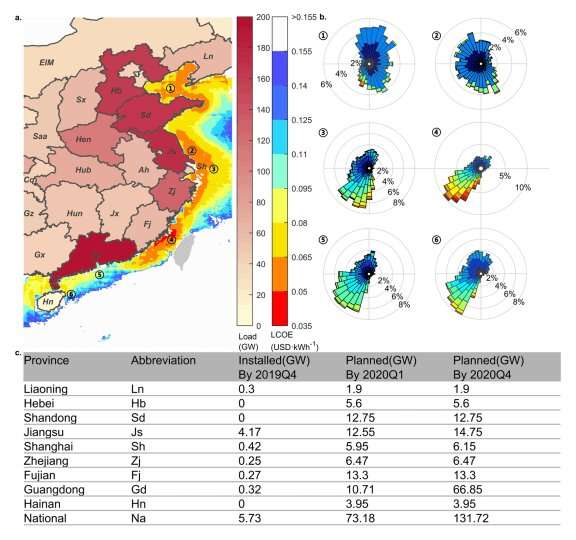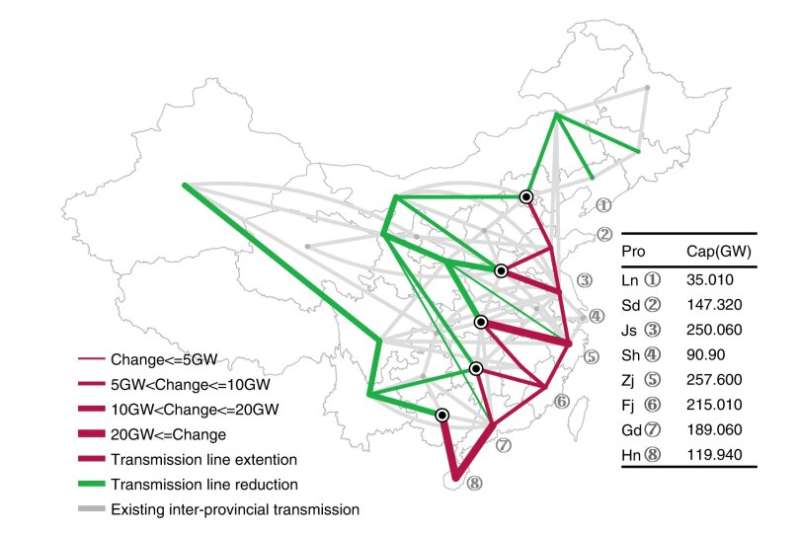This article has been reviewed according to Science X's editorial process and policies. Editors have highlighted the following attributes while ensuring the content's credibility:
fact-checked
peer-reviewed publication
trusted source
proofread
Integrating offshore wind into China's power grid can further carbon neutrality goals

Offshore wind power offers a promising solution to the challenge of decarbonizing coastal China. China's coastal provinces, though small in land mass, are home to 76% of the population; they are also responsible for 72% of total national power consumption and 70% of total CO2 emissions. Transitioning the coastal areas away from fossil fuels is one of China's core challenges for achieving carbon neutrality by 2060, and offshore wind power may hold the key.
New research published in Nature Communications develops a bottom-up model to test the capabilities of the grid to accommodate renewable power variability and to design the optimal investment plans for offshore wind power.
The new paper from the Harvard-China Project on Energy, Economy and Environment, a U.S.-China collaborative research program based at the Harvard John A. Paulson School of Engineering and Applied Sciences (SEAS), and collaborators at Huazhong University of Science and Technology (HUST) in China, is one of the first to analyze opportunities for province-by-province grid integration of renewables at elevated levels of offshore investment.
China's onshore wind investment, accounting for over 80% of national and 30% of global wind commitments, has both significantly less output in winter and limited grid flexibility. Other zero-carbon energy sources like solar and nuclear power also have financial, geographic, and safety constraints. Offshore wind, on the other hand, can provide a more optimal renewable energy resource.

"The results indicate that at least 1,000 GW of offshore wind capacity could already be available at a levelized cost below that for nuclear units in China," explains Michael McElroy, Gilbert Butler Professor of Environmental Studies at SEAS and chair of the Harvard-China Project. "We found that offshore wind investment levels could be more than double the current government target."
To create the optimal deployment plan for offshore wind, the researchers led also by Prof. Xinyu Chen of HUST, an alumnus of the Harvard-China Project, designed a high-resolution assessment model of China's provinces. The model combines a refined analysis of offshore wind resources and economics; considers the micro siting of wind farms with optimization of the delivery system; and simulates hourly power system demands, identifying optimal plans for provincial investments in offshore installations, transmissions and storage.
The modeled system doubles current offshore wind investment by 2030. It also improves current provincial deployment plans for offshore wind, shifting part of the investment from Guangdong to provinces such as Jiangsu and Zhejiang. As a result, the plan could boost national renewable penetration from 31.5% to 40%, at a cost lower than that anticipated in the current plan. By 2050, offshore wind capacity in China could reach as high as 1500 GW.
"China has abundant wind resources and favorable sea depth conditions to develop offshore wind power," says says Xinyang Guo, a visiting fellow with the Harvard-China Project, Ph.D. candidate at HUST, and first author of the paper. "Deployment of offshore wind farms in China could not only provide the largest market for the global wind industry in the upcoming decade, but it could offer also an important building block for China to transition away from fossil fuel-based energy systems."
More information: Xinyang Guo et al, Grid integration feasibility and investment planning of offshore wind power under carbon-neutral transition in China, Nature Communications (2023). DOI: 10.1038/s41467-023-37536-3

















